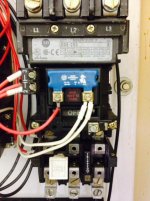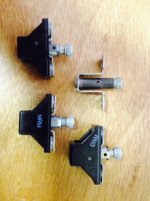Tom,
Thanks for your analysis. I went back and tried a few configurations of the heaters, and yes, with both styles (plastic case and plain metal), you can see whether the contacts contact the ratchets. I have isolated the T2/middle contact as being the issue, as when you press the reset button, the other two contacts/ratchets engage.
There appears to be some damage to the contact area of T2 (see photo). Not completely sure, but it appears that we may have been running the grinder with the heater put in the wrong way on T2. There was the metal heater in that slot (no plastic case, and it may have been inserted the wrong way. I guess that is one benefit of the plastic type of heater -- totally idiot proof.
The damage to the back of T2 seems to be incidental (when I move the contacts with the reset button, it appears to move the same as T1 and T2, and the contact shape and surface appear to be substantially similar. Nevertheless, it is not engaging. So, I am getting a used relay sent to me, and will swap it out. I hope this solves the issue.
I am, with some fiddling, able to get the middle contact to engage. Can we temporarily run the motor this way, or are we risking any damage by doing so (assuming it runs without immediately tripping again.)?
Two additional questions, as long as I have the ear of a few experts:
1. There is a button on the right side of the relay (to the right of the heaters) that says "To Test Circuit / Press". What does this do? How does one utilize this to test the circuit?
2. One of the main stranded hot wires coming into the starter has scoring on the outside copper strands, where someone was stripping the outer sheath and cut through a portion of the copper strands. Is this a situation that could be affecting the current through this leg? Should I cut this back, or leave it be, as motor

has been operating for 5+ years this way?




